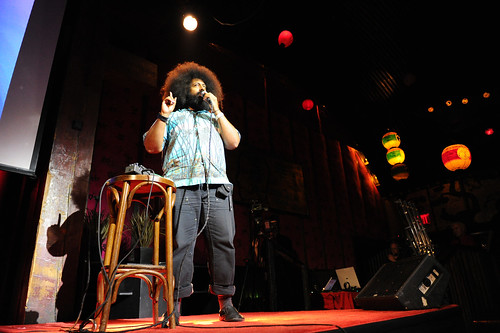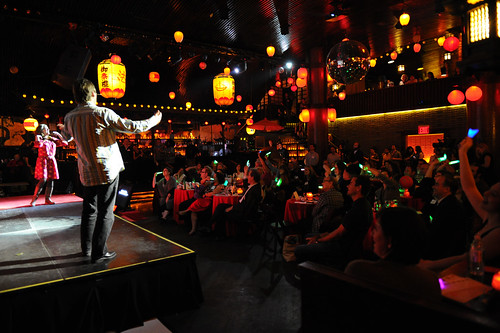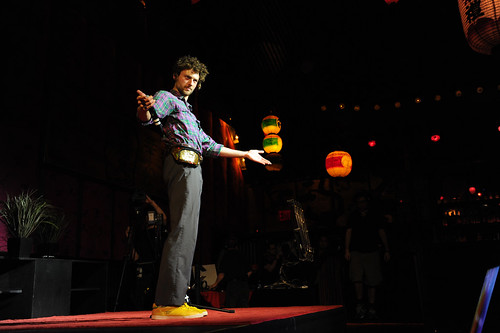Reggie Watts discourses on the nature of TED onstage at TED Full Spectrum Auditions. Credit: James Duncan Davidson. Watch the TED Full Spectrum Auditions archive video >>
Seventeen Full Spectrum audition finalists presented their TEDTalks on Tuesday night at one of the swellest TED venues yet: the Hiro Ballroom in Manhattan (TED’s Corvida Raven shot this panorama from the balcony).
TED’s curator, Chris Anderson, and content director, Kelly Stoetzel, hosted:
Photo: James Duncan Davidson.
The lineup: Dr. Jane Rigby talked about the next wave in space telescopes — what comes after Hubble? During the talk and afterward, Dr. Amber Straughn took questions via Twitter as @Astraughnomer.
Architect James McBennett shared a simple, stunning idea: Why hasn’t the brick changed in 6,000 years? The future of cities is built of brick, built ad hoc as need arises. We can make bricks better, lighter, even self-assembling. (Side note: McBennett, who came here from Ireland, brought with him a next-wave brick he’d made on a 3D printer. But customs seized the brick, suspicious it contained contraband, and smashed it.) Regardless of lack of props, it’s a huge idea.
The amazing Onyx Ashanti stepped onstage wearing an iPhone strapped to his arm, a brick-size controller in each hand, and a custom mouthpiece molded of silicon — and proceded to improvise 6 minutes of “beatjazz,” controlled by body movements. Read more about him on the MAKE blog >>
Starting her talk in a rocking chair, wrapped in an old-lady robe, Beth Urech stepped up to say: “I was born in 1941. The same year as Wonder Woman!” Her talk was a reminder to people of “a certain age” not to ever quiet down.
Medical visualizer Virgil Wong talked about his work knitting together portraiture and medical data, using art to help people tell the stories of their bodies and the illnesses they’ve survived. Insanely quotable: “Medicine helps us live longer lives. But art is why we live.”
Storyteller Joe Sabia used his iPad to connect with the ancient and ever-evolving art of entertaining an audience, starting with the story of Lother Meggendorfer, creator of the first pop-up books.
Lior Zoref had to get a visa to come here from Israel, in a hurry. His visa man asked, “What are you going to the US for?” Lior: “to give a TEDTalk.” Visa man: “I love TED! Approved!” His talk was crowd-sourced among his network on Facebook. He even crowdsourced his closing line — now the headline of this post.
The Flux Foundation presented the collaborative installation they built at Burning Man in 2010, and talked about the nonprofit arts organization they created as a result of that project. An audience-participation project involving postcards was seeded at the Tuesday event … UPDATE: and here’s what happened …
Speed painter Erik Wahl whipped out a new perspective on a familiar face while philosophizing about vision.
Digital luthier Eric Singer showed off and played some of the new instruments he has built. Why create new instruments, when we have plenty of old ones? Because it expands what we can create musically, expands creativity, unlocks a masterpiece that’s just waiting for the tools to be built to express it.
Sound visualizer Jared Ficklin showed how to express music with data and with fire. Fire codes prevented him from demoing his flame table at the Hiro Ballroom, but you can find fabulous video on his site. In the second half of his talk, he showed song visualizations that might point toward the future of finding music we like.
When he was a teenager, comedian Joshua Walters had an episode of mental illness that left him pretty sure he was Jesus Christ. It wasn’t all bad, he says: “There’s no drug that can get you as high as you feel when you think you’re Jesus.” He talked the balancing act between mental illness and “mental skillness” — surfing the wave of whatever your damage is.
Geek Cesar Kuriyama has been capturing one second of video every day. It’s a simple idea but incredibly powerful — read our postshow Q&A with Cesar and watch his video . Many people left the ballroom having committed to do this. If you have too, hit up the comments and let’s get a group started over at TED Conversations.
We all speak “ball,” says Kevin Carroll, who took the stage with beatboxer Shamik Dynamic to tell the story of how a ball saved his life, and how he’s playing it forward by traveling the world sharing the connecting power and joy of throwing, catching, kicking a ball.
Racer, maker and entrepreneur Chris Plough told the story of how he and his team at Oznog Racing drove a used ambulance from the UK to Mongolia, and what they learned along the way. A sweet story with a powerful punch.
Tania Luna talked about surprise. She’s a “surprisologist” who creates experiences that shake people out of their ruts. Because, as she says: “Surprise intensifies our emotions and senses. We pay attention. When we’re surprised, we learn.” Did her TEDTalk turn into a dance party? Yup. Shouldn’t they all?
Reggie Watts gave a discourse on the very nature of the TEDTalk and TED itself, looped in on itself. It was raw and immediate and spectacular.
Watch the TED Full Spectrum Auditions archive video >>
See photos of the show and portraits of the speakers on Flickr >>
Follow most of these finalists on Twitter >>
This crowdsourced headline courtesy adividedbys
Joshua Walters onstage. Photo: James Duncan Davidson



Comments (8)
Pingback: Great Minds Think Alike « Changing the Way You Work
Pingback: TEDxÖrebroLive 2012 – Pass 3: Massan | TEDxÖrebro
Pingback: What to know how to get invited to speak at TED? | beckyblanton
Pingback: This is what I can teach you… – Flux Foundation